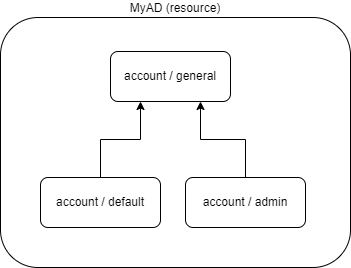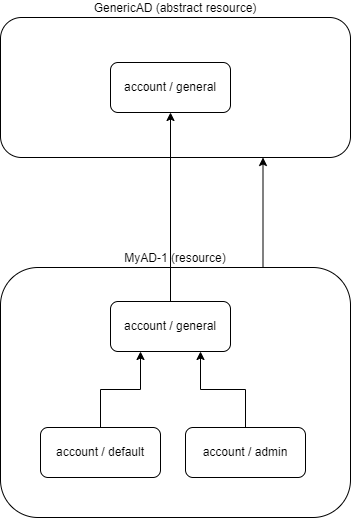
Resource and Object Type Inheritance
|
Since 4.6
This functionality is available since version 4.6.
|
When configuring resources in the past, some amount of copy-and-paste work was inevitable: either when dealing with multiple object types in a resource, or across similar resources. However, this is no longer the case. MidPoint provides the feature of inheritance between resources as well as between individual object types.
Resource Inheritance
A resource can specify its super-resource (a parent) of which it inherits the configuration.
A typical use of this feature would be to implement so-called resource templates: abstract configurations, that can be made operational by filling-in missing configuration pieces, like specific connection parameters, credentials, or other specific configuration item.
| The current implementation is limited to a single parent for each particular resource. (Parents can be chained, so a resource can have a parent, grandparent, grand-grand-parent, and so on.) In the future, we may relax this single-parent limitation, and allow a resource to inherit from more ancestor, allowing some common configuration fragments to be injected into multiple resources at once. |
Object Type Inheritance
Independently of resource inheritance, any object type defined within a resource (like e.g. account/default) can have its super-type defined.
The super-type can be either explicit or implicit:
-
explicit super-typing occurs when the super-type is explicitly mentioned in the object type definition; it has to have a different identification (kind-intent pair);
-
implicit super-typing occurs in connection to resource inheritance: all object types defined in the parent resource automatically become super-types for corresponding object types defined in the child resource (if such object types in child resource do exist).
| The current implementation is limited to a single parent for each particular object type. (Again, parents can be chained, just like for resources.) This also means that explicit and implicit inheritance cannot be applied at the same time: if there is an object type with implicit supertype, it cannot have an explicit super-type defined. |
Examples

Here we see MyAD resource, with object type of account/general that has two (explicitly defined) subtypes: account/default and account/admin.

MyAD-1 resource inherits from abstract GenericAD resource that serves as a template (in this case).
The object type account/general in MyAD-1 is an implicit child of account/general in GenericAD, and - at the same time - it is an explicit parent of account/default and account/admin in MyAD-1.
Configuring Resource Inheritance
The super-resource is defined by including the super item in the child resource configuration:
<resource oid="...">
<name>MyAD-1</name>
<super>
<resourceRef oid="873a5483-ded8-4607-ac06-ea5ae92ce755"/> <!-- GenericAD -->
</super>
...
</resource>The referenced super-resource may or may not be a fully-functional one. It may well be so that it is only a template, lacking key information necessary to connect to it, obtain its schema and capabilities, and so on.
There are two relevant properties here:
-
If
templateis set totrue, it tells midPoint that this is in fact a template that is to be presented to users in Resource Wizard as a starting point for creation of new resources. -
If
abstractis set totrue, it tells midPoint to avoid using this resource directly, because it lacks the necessary information needed e.g. to connect to it. The templates are usually abstract resources.
<resource oid="873a5483-ded8-4607-ac06-ea5ae92ce755">
<name>GenericAD</name>
<template>true</template>
<abstract>true</abstract>
...
</resource>Configuring Object Type Inheritance
For implicit inheritance, nothing needs to be configured: the inheritance relation is established automatically based on matching kind and intent in parent and child resource definitions.
The explicit type inheritance is defined like this:
<resource oid="...">
...
<schemaHandling>
<objectType>
<kind>account</kind>
<intent>default</intent>
<super>
<kind>account</kind>
<intent>general</intent>
</super>
<attribute> <!-- Existing attribute -->
<ref>ri:drink</ref>
<tolerant>false</tolerant> <!-- Overriding the default value -->
</attribute>
</objectType>
<objectType>
<kind>account</kind>
<intent>admin</intent>
<super>
<kind>account</kind>
<intent>general</intent>
</super>
<attribute> <!-- Existing attribute -->
<ref>ri:drink</ref>
<documentation>Administrators do not drink!</documentation>
<limitations>
<processing>ignore</processing>
</limitations>
</attribute>
</objectType>
<objectType>
<kind>account</kind>
<intent>general</intent>
<abstract>true</abstract>
<objectClass>ri:AccountObjectClass</objectClass>
<attribute>
<ref>ri:drink</ref>
...
</attribute>
</objectType>
</schemaHandling>
</resource>We see two concrete object types (account/default and account/admin) inheriting from an abstract one: account/general.
They both modify the definition of ri:drink attribute.
The former changes the tolerant flag to false, while the latter sets the attribute as ignored.
More on the exact merging algorithms is in the following section.
Samples
Sample abstract and specific CSV resource can be seen here:
Security Aspects
If an untrustworthy user is allowed to create a resource with the super item (or add that item to an existing resource), it may compromise the system security.
The reason is that the resolution of super-resources is a low-level operation that cannot be restricted by authorizations.
In other words, once there is a resource with super item set, whoever can read or use that resource object, can do that regardless of whether he/she has the authorization to read or use the referenced super-resource.
Therefore, especially for multi-tenant environments, creation of a resource object with super item has to be restricted.
For example, an authorization like the following one can be used:
super item<authorization>
<action>http://midpoint.evolveum.com/xml/ns/public/security/authorization-model-3#add</action>
<action>http://midpoint.evolveum.com/xml/ns/public/security/authorization-model-3#modify</action>
<object>
<type>ResourceType</type>
</object>
<exceptItem>super</exceptItem>
</authorization>A holder of the above authorization can add and modify resource definition objects, except for their super item.
So, any resource added must not have that item present; and any modification to existing resource must not manipulate super item as well.
Tips and Tricks
Disabling Synchronization Reaction
If you need to disable a specific synchronization reaction present in the parent resource, you can override its lifecycleState property to a value that effectively disables it (in the child resource).
A good candidate is the value of draft.
So, for example, if you have a reaction like this:
<synchronization>
...
<reaction>
<name>new-accounts</name>
<situation>unmatched</situation>
<actions>
<addFocus/>
</actions>
</reaction>
</synchronization>You can disable it in this way:
<synchronization>
<reaction>
<name>new-accounts</name>
<lifecycleState>draft</lifecycleState>
</reaction>
</synchronization>The prerequisite is that the reaction is named, so that it can be referred to in the child resource.
Addendum: Configuration Merging Algorithm Details
| TL;DR Atomic values are overridden, composite values are merged. Values of multivalued items are put together, and the ones that refer to the same entity (connector, attribute, mapping, and so on) are merged. |
When a resource or an object type inherits from its parent, a configuration merge operation is executed. The merging process starts from the top of the hierarchy: the first-level child is merged with the top object. Then the second-level child is merged with the (already merged) first-level child, and so on, down to the object at the bottom of the hierarchy.
The merge operation looks like this:
-
When merging an object, all its items are merged.[1]
-
When merging an item, there are two cases:
-
If the item is single-valued (i.e. it can - by definition - have at most one value), then the item is either replaced or merged.
-
The former case is applied to so-called (atomic) properties and references. A typical property is e.g.
name. An example of a reference is e.g.connectorRef. So, no merging of the content of these two kinds of items occur. They are simply replaced as a whole. -
The latter case (merging) is applied to (structured) containers. A typical container is e.g.
connectorConfiguration. It is recursively merged using the same algorithm as is applied to the resource as a whole.
-
-
If the item is multivalued (i.e. it can have more than one value), then the algorithm is a bit more complex. It tries to find matching values that are present on both sides, and then - for each such matching pair - creates a single merged value, instead of copying both of them. The non-matching values are simply copied as they are.
-
Finding Matching Value
Currently, the following types of items have defined so-called keys, i.e. properties that are used to find matching values of given item type.
| Item | Type | Key |
|---|---|---|
|
|
|
|
|
|
| Item | Type | Key |
|---|---|---|
|
|
|
all mappings |
|
|
|
|
|
|
|
|
|
|
|
|
|
|
|
|
|
|
|
|
Notes:
-
Although being structured, expressions in mappings are properties, not containers. So they are being replaced, not merged. This may change in the future.
-
Outbound mappings for attributes and associations are single-valued, so they are merged automatically (without using a name to pair them). However, outbound mappings for special properties (e.g. password) are multivalued, so they are appended just as inbound mappings are.
-
The static schema is inherited as a whole, i.e. as an atomic property. It is expected that parent resources will not have the schema; but if they are not abstract, they will eventually have one. In order for the current implementation to work, such (non-abstract) resources in parent-child relationship need to have the same schema.
-
Merging of the legacy (detached)
synchronizationsection was not treated in any special way. The standard algorithm will be used; no attempts to find matching values of items are made. We recommend migrating to the new object-type specific synchronization configuration. -
Resource name is always required: it will not be inherited from the parent.
name, description, documentation, connectorRef, connectorConfiguration, additionalConnector, schema, schemaHandling, and so on.
correlation/correlators/definitions/items/item or correlation/correlators/definitions/places.